- Messages
- 654
- Reaction score
- 0
- Points
- 0
Doris, your wish is my command! Meet some of my old, deceased dogs with their angles drawn in!!!doris said:great posts, I'm loving this thread :thumbsup:
and if anyone wants to show some examples of shoulder angles, I for one would be very interested to see them :- "
like the ones earlier with rear angulation
Bear in mind that angulation is a way that people describe the imaginary lines drawn between points. Bones aren't straight--bones are curved. But the lines drawn between points show if structure is balanced front to rear, and angulation is sufficent for the standard of that breed (as some want a lot of angulation, such as the Dachshund or Alsatian, while others want less angulation).
I will start with some old champions of mine (no more nicking photos of other people's dogs for me!) who were reckoned to have very good shoulder angles in their day....
Here is a 19 1/2" bitch who had beautifully laid- back shoulders, balanced angles, and as you can see, the plumb bob line is as described earlier in this thread. She has about a 100 degree angle, but her layback is 45 degrees from vertical. The rear angle is matching. The only problem is that her upper arm (humerus) was a tad short, but she moved well in front. I believe this front would pass muster in the UK, or anywhere.
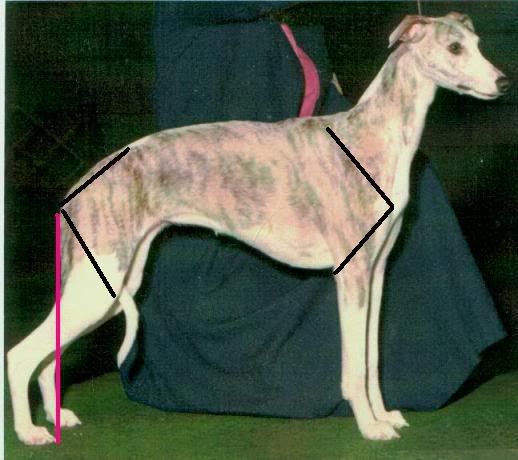
This dog below had a very fine shoulder and angle (also 100 degrees). He had great return of upper arm and a very long upper arm and he had beautiful reach in his profile movement. He also had an extreme rear to match and look how far behind the point of the hip the front toes of his hind foot are. The bones of his humerus (upper arm) correspond to the bones of his second thigh (tibia) and the second thigh is long. This dog had a beautiful front to go over, but a very extreme rear. These things tend to be connected. It's hard to get the rear moderate when you have a front end like his:
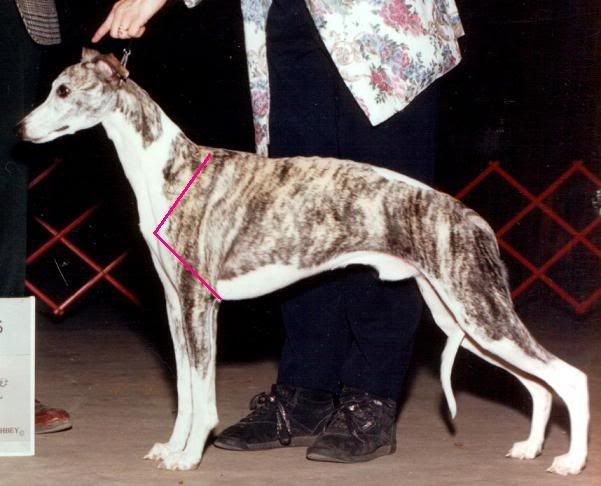
Here is a dog whose photo, unfortunately, is overexposed, but I think he'd be pleasing to most. He has balanced angles, which are also about 100 degrees, and again, the plumb bob line from point of hip to front of foot is close to flush. He is not as extreme in rear as the above example.

The above dog was shown successfully under both the FCI and AKC standard.
Now, I have two from my dual-purpose lineages and you will immediately see a difference. The first bitch is one who was a very fine courser and a very fast racer. I finished her in the AKC pretty quickly. She has balanced angulation, but look at how much more open in angles she is at each end! We have added 10 degrees, and she is a 110 degree angle. In the US, we often refer to this as a good "racing front".
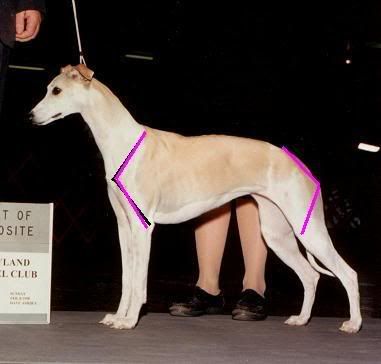
Her plumb bob line holds true. I must say this has been generally a good predictor, along with hipbones the same height off the ground as the shoulder, of speed in my show line. The above bitch made up easily because she was flawless in gait on the line, and although her side gait was not "big", it was level and balanced. She was a very balanced versatility dog. The kind of dog who can be a champion, but is not a top specials or group dog, as her lack of angulation hurts her in side gait and also in terms of the profile she presents when stacked. But many admired dogs here have 110 degree angles. They are great all-around dogs who can get titles in various pursuits.
Now, here is another--not a very good photo since she was in very lean racing weight at the time, but this is probably the fastest racer I've ever bred:
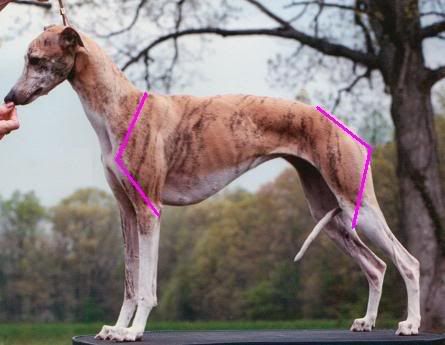
Her angle is a bit more open, still. 115 degrees at best. The biggest difference is that the whole assembly is shifted just a hair forward, which gives a slightly throatier neck and less complete fill than the fawn bitch had. But she is still balanced in angles and was a fine mover at the trot and a very very good producer. But I was not able to finish her in the USA. She earned her Canadian championship in good style.
Now, for a bad example. I'm sorry to say this dog, who I did have a hand in, is an example of probably why a lot of people elsewhere take a dim view of US dogs. He is very elegant in neck and head, and he is flashy in color, with great pigment, but he is not well made, not at all.
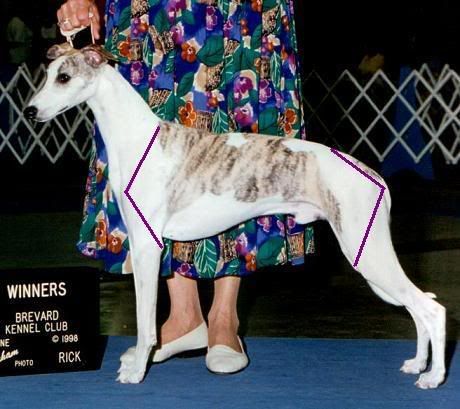
As you can see, his shoulder angle (well over 120 degrees) is more open than his rear angle (110 degrees), and so he is dreadfully unbalanced. He is much too straight in front, and this shows in his more upright pastern. He was a fun dog to show because he was glamorous and judges liked him, but he was neutered thereafter and so was a dead end, due to lack of correct structure. You had to pick just the right speed to gait him or he would bump and hitch due to lack of balance.
IMO, the ideal shoulder angle for a Whippet who is a show dog first and foremost is between 100 and 105 degrees, and for a dog who is meant to also have a bit of speed but still be sound and finishable, you need to look at something which is between about 110-115 degrees. Anything more than that and it's too straight for the show ring. 120 degrees would be the outer limits of what's showable, but that would require a rear to match, flawless soundness, and maybe extreme beauty points of head, neck and underline and a high degree of showmanship.
The computer is great. It's a light screen and you can put white paper over it and trace and draw and have a lot of fun. Find some photos of dogs you like and check out their angles and their balance. You might be very surprised!!!!
Last edited by a moderator:








